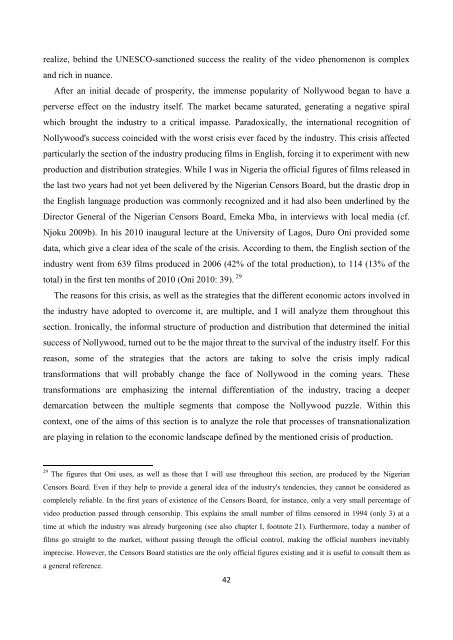Create successful ePaper yourself
Turn your PDF publications into a flip-book with our unique Google optimized e-Paper software.
ealize, behind the UNESCO-sanctioned success the reality of the video phenomenon is complexand rich in nuance.After an initial decade of prosperity, the immense popularity of Nollywood began to have aperverse effect on the industry itself. The market became saturated, generating a negative spiralwhich brought the industry to a critical impasse. Paradoxically, the international recognition ofNollywood's success coincided with the worst crisis ever faced by the industry. This crisis affectedparticularly the section of the industry producing films in English, forcing it to experiment with newproduction and distribution strategies. While I was in Nigeria the official figures of films released inthe last two years had not yet been delivered by the Nigerian Censors Board, but the drastic drop inthe English language production was commonly recognized and it had also been underlined by theDirector General of the Nigerian Censors Board, Emeka Mba, in interviews with local media (cf.Njoku 2009b). In his 2010 inaugural lecture at the University of Lagos, Duro Oni provided somedata, which give a clear idea of the scale of the crisis. According to them, the English section of theindustry went from 639 films produced in 2006 (42% of the total production), to 114 (13% of thetotal) in the first ten months of 2010 (Oni 2010: 39). 29The reasons for this crisis, as well as the strategies that the different economic actors involved inthe industry have adopted to overcome it, are multiple, and I will analyze them throughout thissection. Ironically, the informal structure of production and distribution that determined the initialsuccess of Nollywood, turned out to be the major threat to the survival of the industry itself. For thisreason, some of the strategies that the actors are taking to solve the crisis imply radicaltransformations that will probably change the face of Nollywood in the coming years. Thesetransformations are emphasizing the internal differentiation of the industry, tracing a deeperdemarcation between the multiple segments that compose the Nollywood puzzle. Within thiscontext, one of the aims of this section is to analyze the role that processes of transnationalizationare playing in relation to the economic landscape defined by the mentioned crisis of production.29 The figures that Oni uses, as well as those that I will use throughout this section, are produced by the NigerianCensors Board. Even if they help to provide a general idea of the industry's tendencies, they cannot be considered ascompletely reliable. In the first years of existence of the Censors Board, for instance, only a very small percentage ofvideo production passed through censorship. This explains the small number of films censored in 1994 (only 3) at atime at which the industry was already burgeoning (see also chapter I, footnote 21). Furthermore, today a number offilms go straight to the market, without passing through the official control, making the official numbers inevitablyimprecise. However, the Censors Board statistics are the only official figures existing and it is useful to consult them asa general reference.42
















